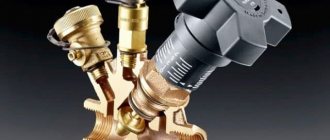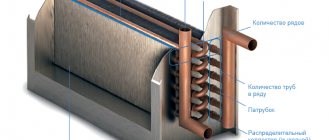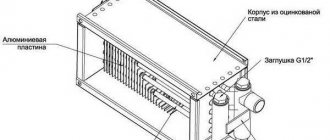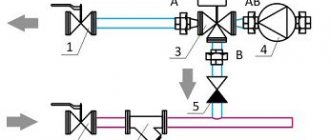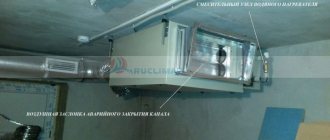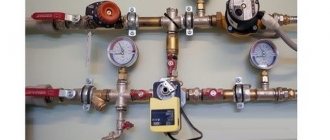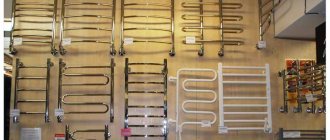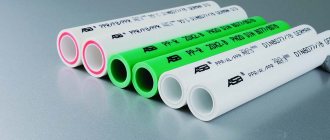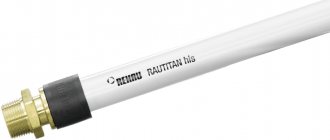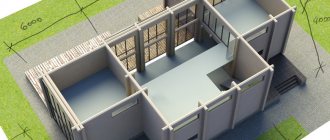Calculation of heat load on hot water supply
Name of object: Beauty salon
Content:
- Initial data
- Calculation of heat load for hot water supply
- Technical conclusion
- List of normative, technical and special literature
- Complete information on calculating thermal loads
Calculation of heat load • Coordination with MOEK
Find out in detail
Other ways to determine the amount of heat
Let us add that there are also other methods by which you can calculate the amount of heat that enters the heating system. In this case, the formula is not only slightly different from those given below, but also has several variations. As for the values of the variables, they are the same as in the previous paragraph of this article. Based on all this, we can confidently conclude that it is quite possible to calculate the heat for heating on your own. However, one should not forget about consulting with specialized organizations that are responsible for providing housing with heat, since their methods and principles of calculations may differ, significantly, and the procedure may consist of a different set of measures.
If you intend to equip a “warm floor” system, then prepare for the fact that the calculation process will be more complex, since it takes into account not only the characteristics of the heating circuit, but also the characteristics of the electrical network, which, in fact, will heat the floor. Moreover, the organizations that install this kind of equipment will also be different.
Note! People often encounter the problem of converting calories into kilowatts, which is explained by the use of a unit of measurement in many specialized manuals, which is called “C” in the international system. >
In such cases, it is necessary to remember that the coefficient due to which kilocalories will be converted to kilowatts is 850
In simpler terms, one kilowatt is 850 kilocalories. This calculation option is simpler than those given above, since the value in gigacalories can be determined in a few seconds, since a Gcal, as noted earlier, is a million calories
In such cases, it is necessary to remember that the coefficient due to which kilocalories will be converted into kilowatts is equal to 850. In simpler terms, one kilowatt is 850 kilocalories. This calculation option is simpler than those given above, since the value in gigacalories can be determined in a few seconds, since a Gcal, as noted earlier, is a million calories.
In order to avoid possible mistakes, we should not forget that almost all modern heat meters operate with some error, albeit within acceptable limits. This error can also be calculated by hand, for which you need to use the following formula:
Traditionally, now we find out what each of these variable values means.
1. V1 is the flow rate of the working fluid in the supply pipeline.
2. V2 – a similar indicator, but in the return pipeline.
3. 100 is the number by which the value is converted to a percentage.
4. Finally, E is the error of the accounting device.
According to operational requirements and standards, the maximum permissible error should not exceed 2 percent, although in most meters it is somewhere around 1 percent.
As a result, we note that a correctly calculated Gcal for heating can significantly save money spent on heating the room. At first glance, this procedure is quite complicated, but - and you have seen this personally - if you have good instructions, there is nothing difficult about it.
That's all. We also recommend watching the thematic video below. Good luck in your work and, as usual, have a warm winter!
Calculation of heat load on hot water supply. Initial data
This calculation was carried out to determine the actual heat load for heating and hot water supply of non-residential premises.
| Customer | Beauty saloon |
| Address of the object | Moscow |
| Heat supply agreement | There is |
| Number of floors of the building | one-story |
| The floor on which the premises being examined | 1st floor |
| Floor height | 2.56 m. |
| Heating system | – |
| Bottling type | – |
| Temperature chart | – |
| Estimated temperature chart for the floors on which the premises are located | – |
| DHW | Centralized |
| Estimated indoor air temperature | – |
| Submitted technical documentation | 1. Copy of the heat supply agreement. 2. A copy of the floor plans. 3. A copy of an extract from the technical passport of the BTI for the building. 4. A copy of the explication of the premises. 5. A copy of the BTI certificate on the condition of the building/premises. 6. Certificate of headcount. |
Problem solving
Let's consider a situation where you made the calculation correctly, but the efficiency indicator is extremely low or you want to improve it even more.
In this case, you should pay attention to:
thermal insulation of the building. Nowadays there are many different methods for insulating buildings, these include sandwich panels, various polypropylene panels installed on the frame, as well as conventional mixtures for finishing and plastering;
Sandwich panel
- mechanisms for adjusting the coolant supply depending on the outside air. There are a huge number of such mechanisms on the heating engineering market. They consist of an external sensor (a kind of thermometer), which transmits readings to a calculating mechanism (microcomputer), which in turn adjusts the fittings;
- it is quite possible that you need to replace your heat source and heating devices with pipelines due to the fact that they are obsolete;
- Perhaps a simple flushing of the heating system will help you. Due to the fact that the heating system is operated with poor quality coolant, deposits can form in equipment and pipelines, which lead to poor coolant circulation.
Pipe clogged from inside
Calculation of heat load for hot water supply
Probability of action of sanitary devices
P = ( qhhr , ux U ) / ( qh 0 x N x 3600 ) = (4 x 12) / (0.1 x 9 x 3600) =0.0148,
where: qhhr , u = 4 l – 1 workplace per shift;
U = 12 people – number of personnel;
qh 0 = 0.1 l/s;
N = 9 – number of sanitary fixtures with hot water.
Likelihood of using sanitary fixtures.
Phr = (3600 x P x qh 0 ) / qh 0, hr = (3600 x 0.0148 x 0.1) / 40 = 0.0888,
where: qh 0, hr = 40;
When Phr < 0.1.
Then a hr = 0.328
Average hourly water consumption.
qt = qhu x U / 1000 x T = 28.1 x 12 / 1000 x 24 = 0.01405 m3/hour
Maximum hourly water consumption.
qhr = 0.005 x qh 0, hr x a hr = 0.005 x 40 x 0.328 = 0.0656 m3/hour
Heat flow.
a) within an hour
QhT = 1.16 x qhT x (65 – tc ) + Qht = 1.16 x 0.01405 x (65 – 5) + 0.048894 = 1.026774 kW x 859.8 = 882.820 kcal / h ( 0. 00088282 Gcal/h)
where: Qht – the share of thermal energy losses in external heating networks of hot water supply is estimated at 5% of the average hourly heat load of the consumer’s hot water supply according to methodological recommendations for determining tariffs and fees for hot water supply services. Qht = 1.16 x qhT x (65 – tc ) x 0.05 = 1.16 x 0.01405 x (65 – 5) x 0.05 = 0.048894 kW.
b) during the hour of maximum consumption
Qhhr = 1.16 x qhhr x (65 – tc ) + Qht = 1.16 x 0.0656 x (65 – 5) + 0.228288 = 4.794048 kW x 859.8 = 4121.9225 kcal / h ( 0.00412192 Gcal/h)
where: Qht = 1.16 x qhhr x (65 – tc ) x 0.05 = 1.16 x 0.0656 x (65 – 5) x 0.05 = 0.228288 kW.
Qh year = gumh ´ m ´ s ´ r ´ [(65 – t s z ) ´ Z z ] ´ (1+ K t.p ) ´ 10-6 = 28.1 ´ 12 ´ 1 ´ 1 ´ [(65 – 5) ´ 365] ´ (1+ 0.05) ´ 10-6 = 7.753914 Gcal/year
where: gumh = 28.1 l/day
Since the calculation formula Qh year does not take into account the number of days the hot water supply is turned off per year; the temperature of cold water in the summer, the coefficient of thermal losses Kt.p is taken equal to the share of thermal energy losses in external heating networks of hot water supply in the amount of 5% of the annual heat load.
calculations
A theory is a theory, but how is the cost of heating a country house calculated in practice? Is it possible to estimate cost estimates without going into the depths of complex thermal formulas?
Consumption of the required amount of heat
The instructions for calculating the estimated amount of heat required are relatively simple. The key phrase is an approximate number: we focus on accuracy to simplify calculations, ignoring many factors
- The basic value of the amount of thermal energy is 40 W per cubic meter of house volume.
- 100W per window and 200W per door in external walls are added to the base power.
Then the resulting value is multiplied by a coefficient, which is determined by the average amount of heat loss along the external contour of the building. For apartments in the center of a residential building, one factor is accepted: only losses in the facade are noticeable. Three of the four contour walls of the apartment border warm rooms.
For corner and end apartments, a coefficient of 1.2-1.3 is assumed depending on the wall material. The reasons are obvious: two or even three walls become external.
Finally, in a private house the street is located not only along the perimeter, but also below and above. In this case, a coefficient of 1.5 is used.
In cold climate zones there are special heating requirements.
Let's calculate how much heat a cottage of 10x10x3 meters needs in the city of Komsomolsk-on-Amur, in Khabarovsk.
The volume of the building is 10 * 10 * 3 = 300 m3.
Multiplying the volume by 40 watts/cube will give 300 * 40 = 12000 watts.
Six windows and one door 6 * 100 + 200 = 800 W. 1200 + 800 = 12800.
Private house Factor 1.5. 12800 * 1.5 = 19200.
Khabarovsk region. We need heat one and a half times: 19200 * 1.5 = 28800. In general, at the peak of frost we need a boiler with a capacity of 30 kilowatts.
Calculation of heating costs
The easiest way is to calculate electricity consumption for heating: when using an electric boiler, it is exactly equal to the cost of thermal energy. With continuous consumption of 30 kilowatts per hour, we will spend 30 * 4 rubles (approximate current price of a kilowatt-hour of electricity) = 120 rubles.
Fortunately, the reality is not so scary: as practice shows, the average heat requirement is approximately half of what is expected.
- Firewood - 0.4 kg / kW / h.
The approximate rate of firewood consumption in our case will be equal to 30/2 (the nominal power, as we remember, can be divided in half) * 0.4 = 6 kg per hour. - Lignite consumption per kilowatt of heat is 0.2 kg.
In our case, coal consumption rates for heating are calculated as 30/2 * 0.2 = 3 kg/hour.
Lignite is a relatively inexpensive heat source.
- For firewood - 3 rubles (cost per kilogram) * 720 (hours per month) * 6 (hourly consumption) = 12960 rubles.
- For coal - 2 rubles * 720 * 3 = 4320 rubles (read others).
List of normative, technical and special literature
Heat consumption is calculated in accordance with and taking into account the requirements of the following documents:
- Methodological guidelines for determining the consumption of fuel, electricity and water for heat production by heating boiler houses of municipal heat and power enterprises (SUE Academy of Public Utilities named after K.D. Pamfilov, 2002);
- SNiP 23-01-99* “Building climatology”;
- Calculation of central heating systems (R.V. Shchekin, V.A. Berezovsky, V.A. Potapov, 1975);
- Designer's Handbook “Internal Sanitary Installations” (I.G. Staroverov, 1975);
- SP30.13330 SNiP 2.04.-85* “Internal water supply and sewerage of buildings.”
- “Technical regulations on the safety of buildings and structures.”
- SNiP 23-02-2003 “Thermal protection of buildings”
- SNiP 23-01-99* “Construction climatology”
- SP 23-101-2004 “Design of thermal protection of buildings”
- GOST R 54853-2011. Buildings and constructions. Method for determining the heat transfer resistance of enclosing structures using a heat meter
- GOST 26602.1-99 “Window and door blocks. Methods for determining heat transfer resistance"
- GOST 23166-99 “Window blocks. General technical conditions"
- GOST 30971-2002 “Mounting seams of junctions of window blocks to wall openings. General technical conditions"
- Federal Law of the Russian Federation of November 23, 2009 N 261-FZ “On energy saving and increasing energy efficiency, and on introducing amendments to certain legislative acts of the Russian Federation.”
- Order of the Ministry of Energy of Russia dated June 30, 2014 N 400 “On approval of the requirements for conducting an energy survey and its results and the rules for sending copies of the energy passport drawn up based on the results of the mandatory energy survey.”
View other heat load reports.
The procedure and rules for determining the construction volume of a building without attic space. TZiS.
The construction volume of the ground part of the building without an attic floor should be determined by multiplying the vertical cross-sectional area by the length of the building, measured between the outer surfaces of the end walls in the direction perpendicular to the cross-sectional area at the level of the first floor above the base.
The vertical cross-sectional area should be determined by the contour of the outer surface of the walls, by the upper outline of the roof and by the level of the finished floor of the floor. When changing the cross-sectional area, architectural details protruding on the surface of the walls, as well as niches, should not be taken into account.
Similar
| Ministry of Education and Science, Youth and Sports of Ukraine National Metallurgical Academy of Ukraine Yu. A. Gichev. Heat supply sources for industrial enterprises. Part I: Lecture notes: Dnepropetrovsk: NmetAU, 2011. – 52 p. | Ministry of Education and Science of Ukraine Ministry of Industrial Policy of Ukraine National Metallurgical Academy of Ukraine - State Institute for Training and Retraining of Industrial Personnel (Gipoprom) Edited by Professor Shestopalov G.move to 0-16320291 |
| Ministry of Education and Science of Ukraine Ministry of Industrial Policy of Ukraine educational and scientific complex "National Metallurgical Academy of Ukraine State Institute for Training and Retraining of Industrial Personnel (Gipoprom)" Edited by Professor Shestopalov G.move to 0-3612123 | Ministry of Education and Science, Youth and Sports of Ukraine National University of Physical Education and Sports of UkraineThe work was carried out at the National University of Physical Education and Sports of Ukraine, Ministry of Education and Science, Youth... |
| Ministry of Education and Science, Youth and Sports of UkraineMinistry of Education and Science, Youth and Sports of Ukraine, Sevastopol National Technical University (Sevntu) from 23 to… | Ministry of Education and Science, YOUTH AND SPORTS OF UKRAINE Ministry of Education and Science, Youth and Sports of the Autonomous Republic of Crimea RVU "Crimean Humanitarian University" (Yalta) Institute of Economics and Management control work in the discipline |
| Ministry of Education and Science of Ukraine Ministry of Industrial Policy of Ukraine National Metallurgical Academy of Ukraine - State Institute for Training and Retraining of Industrial Personnel (Hypoprom) Edited by Professor Shestopalov G. Sociology. Course of lectures // Shestopalov G. G., Amelchenko A. E., Kurevina T. V., Laguta L. N., edited by Prof. G. G. Shestopalov. – Dnepropetrovsk:... | National University of Physical Education and Sports of Ukraine Gridko Lyudmila AnatolievnaThe work was carried out at the National University of Physical Education and Sports of Ukraine, Ministry of Education and Science, Youth... |
| National University of Physical Education and Sports of UkraineThe work was carried out at the National University of Physical Education and Sports of Ukraine, Ministry of Education and Science, Youth... | National University of Physical Education and Sports of UkraineThe work was carried out at the National University of Physical Education and Sports of Ukraine, Ministry of Education and Science, Youth... |
Documents
Documents
